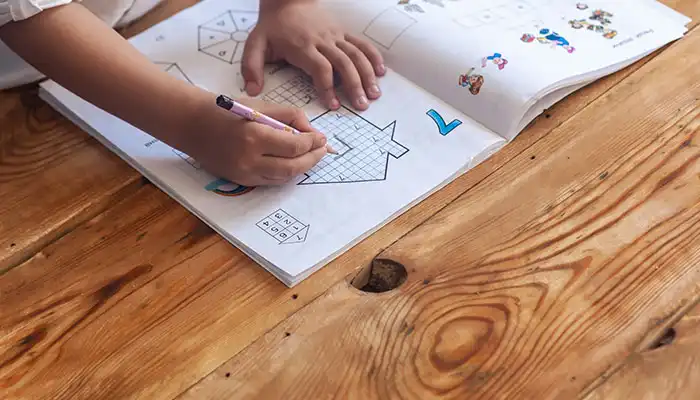Preschool Tracing Worksheets Free: The Ultimate Tool for Early Writing Success
Preschool tracing worksheets free pdf — the answer to your question: how do we help little ones lay a foundation for writing — is much simpler than it might seem. These easy-access, downloadable resources are more powerful than you would believe. We’re not talking ‘just’ tracing — we’re talking about the pre-writing skills that lead to effective writing skills and much more confident writers. Tracing worksheets for preschoolers free? It truly is a thing.
Why Preschool Tracing Worksheets Free Are Essential
Here comes the science behind why preschool tracing worksheets free activity are so necessary. We all know that preschool is where children learn to write. But being able to pick up a pencil and scribble on paper doesn’t necessarily mean that a child is ready to form letters. Writing is difficult. It requires hand-eye coordination, fine motor skills, and muscle control. So where do these skills come from? Through tracing, of course! Tracing activities teach preschoolers the physical tools needed to shape lines, curves, and shapes that later forms their letters and numbers.
When a child traces, they are not just following a line – they are mastering the pencil, learning how to move their hand around the page, and holding their focus, all of which is key to handwriting.

Types of Preschool Tracing Worksheets Free
There is no such thing as just one “tracing sheet” for preschoolers, and good thing! Variety is essential when it comes to helping kids stay engaged, and it allows them to develop a variety of skills. Take a closer look at the various types of free preschool tracing worksheet available for use at home to support your kid’s early learning.
-
Alphabet Tracing Worksheets
Tracing alphabet worksheets are a mainstay of early education. Students practise these alphabet worksheets in order to learn how to form the letters of the alphabet, upper and lowercase.
Imagine your child tracing the letter ‘A’ on a worksheet: they begin at the top and trace the dashed lines down and across, then repeat the process until the ‘A’ takes shape. In due course, these compositional exercises help your child recall how each letter is formed, and ease the journey into independent writing.
Tracing those shapes of letters and seeing both the form and the function enhances their literacy development. Alphabet tracing is not just about learning a set of shapes, it is also about learning a set of sounds. The overlap of visual learning and auditory learning is important for learning letters.
-
Number Tracing Worksheets
They learn how to write letters in the same way they learn how to write numbers. Number tracing sheets help children learn how to recognise and write the numbers 0 to 9. They usually involve tracing the numbers, counting objects, and matching numbers to quantity.
Pretend your child is tracing the number ‘5’ while putting five apples on a page. She’s learning that a specific number of strokes associates with a particular piece of writing, and realises that it represents the same quantity as the first object. She’s learning to count and write at the same time.
Tracing numbers is especially fundamental because children must get used to the shape of the digits if they are to prepare for future maths. Being able to annotate the numbers even at kindergarten age is a really sound preparation for more advanced maths.
-
Shape Tracing Worksheets
Shapes form the base or roots of both alphabets and numerals. Shape tracing worksheets allow the children to learn the shapes and replicate them on paper. These worksheets serve for the growth of fine motor skills and eye to hand coordination along with inclusion of Geometry to the tiny minds.
Consider this worksheet – once your child has drawn a circle, a square, and a triangle, cueing him to trace along those lines, he’s growing accustomed to pencil pressure: how to anchor and angle as he moves the pencil around his paper to create a perfectly round circle, a perfectly fixed square, and an evenly distributed triangle. When kids grow older, many of their initial lines will be composed of just these basic shapes.
Shape tracing also encourages understanding of spatial relations which, while important for writing, is also key for reading and maths. Understanding and drawing shapes provides the scaffold from which more complex geometric concepts can be learnt.
-
Line and Pattern Tracing Worksheets
Children learn to scribble freehand before they learn to write letters and numbers, so tracing-line and pattern worksheets are the perfect tool to introduce them to straight-lines and curves and all the other simplified patterns that are required for young ones to practice their fine motor skills.
Visualise your child taking her finger and tracing a series of gently wavy lines over and over, focusing intently as she tries to stay right on the line. Repetitions like this help to build the muscle memory and dexterity for when she’s ready to start writing letters and numbers.
But pattern tracing is additionally valuable as a first introduction to the fundamental element of both writing and reading: repetition. Making a pattern and learning to recognise it is an early clue to the structure of the letter, the word, the sentence.
-
Dot-to-Dot Tracing Worksheets
Dot-to-dot tracing worksheets are a great way to practice tracing. Often, dot-to-dot tracing sheets require you to connect numbered dots that form a picture, such as an animal, a vehicle or a favourite character. Connecting the dots helps students trace, recognise numbers, activate fine motor skills and follow a sequence.
If you have a child who’s starting to trace on worksheets and they connect four dots to find the head of a dinosaur, what they’re really doing is working on their order of numbers together with their ability to count and trace, not to mention the fun of completing a picture. This can give kids a real confidence boost.
Why do dots-to-dots work especially well? Because they are a multiple benefit activity. They involve not just tracing, but counting, number recognition, following instructions and more.
Where to Find Preschool tracing worksheets free
By now, you have a general idea of the types of Preschool tracing worksheets free you can get. Now, where can you get these preschool tracing worksheets free? Here are the best places for free preschool tracing worksheets.
-
Educational Websites
There are many websites with excellent free preschool tracing worksheets. Here are several of the best:
- Twinkl: This free resource provides preschoolers with the opportunity to trace letters, numbers, shapes and patterns with well-designed, easy-to-download worksheets. Schools and their parents love it!
- Education.com: This site provides free online tracing worksheets for early writing, including alphabet tracing, number tracing, and tracing shapes.
- Teachers Pay Teachers: Although much on this site costs money, you can also find preschool tracing pages which are absolutely free. Payment is in the form of downloading other resources which are free, and which create revenue for the teachers behind the website. These preschool tracing pages have been classroom-tested, so you know they work well.
-
Local Libraries and Community Resources
Don’t overlook your local library. In fact, local libraries are a wonderful source for free printable tracing worksheets. Those should be available for you, either through various library portals or various books that nobody’s checking out that you can copy and take.
-
Preschools and Early Learning Centres
If your child is in preschool, then the school itself is a common source for free tracing materials. Many teachers share worksheets with parents so their students can continue learning at home. I suggest that you always ask your child’s teacher for suggestions.
Benefits of Using Tracing Worksheets for Preschoolers
Thus, why precisely should you use preschool worksheets pdf printing free? Let’s found out the advantages.
-
Fine Motor Skill Development
Tracing worksheets can be good for developing fine motor skills, which are necessary for writing. Children have to move their hands with control in order to make the lines, shapes and letters along with the image. As they trace, they’re strengthening the tiny muscles in the hands and fingers, giving them more control over the writing tool.
-
Pre-Writing Skill Enhancement
Long before a child is ready to write letters and numbers unassisted, he or she needs the muscle memory and control to form the shapes. Tracing sheets provide pre-writing practise in a targeted, precisely structured way.
-
Engagement and Fun
The main challenge to early education is keeping children engaged; tracing worksheets, particularly fun ones or ones that allow for interactive elements, turn learning into a game. When kids are having fun they are more likely to stay focussed and learn what they’re practising.
Tips for Maximising the Use of Preschool Tracing Worksheets Free
Once you’ve printed the worksheets you want, how can you use them well? Here’s a guide to sustainable and efficient use of preschool tracing worksheets free.
-
Incorporate into Daily Routines
When introducing new skills, helping your preschooler stay consistent with practice can make it easier for him or her to learn – how about practicing tracing first thing in the morning before breakfast and after school each day?
-
Combine with Hands-On Activities
Worksheets are useful and educational, but they are even more effective when paired with an engaging hands-on activity. Go beyond the pages: pair a tracing worksheet with a container of playdough for letter-shaping, or fill a shallow dish with sand and encourage your child to trace with a make-believe ‘magic’ stick or feather. In these activities, your child can practise and reinforce the skills they’re learning in two different modes: one visual, and one hands-on and tactile.
-
Encourage Independence
Another of the great benefits I find for worksheets is that they can foster independence. While the power of praise is exaggerated in parenting culture today and should not be relied on too heavily, getting your child the occasional positive feedback for a job well done is not a bad idea. Create a simple learning station where they can access their worksheets, pencils and crayons, place them at the table (which you might want to set up in an out-of-the-way, low-traffic area, as a top priority might be for your child to focus), and let them work on a worksheet while you prepare dinner, fold laundry or finish Christmas shopping.
-
Use Themed Worksheets
You know… variety is the spice of life! Try using themed tracing worksheets to spice up your day. Do holiday-themed pages for Christmas and Halloween. Find worksheets featuring your child’s favourite characters. This keeps learning fresh, interesting and something your child is excited to be a part of.
Taking Preschool Tracing Worksheets Free to the Next Level
Preschool tracing worksheets free pdf are not just about learning to write but also about having your child develop fine motor skills, so using them at home or in school is an extremely important part of your child’s development. But what tricks are there to make these worksheets more fun and more beneficial for your child? Let’s look deeper into more strategies that can make tracing work for your kid, and make it exciting for them.
Incorporating Preschool Tracing Worksheets Free into Everyday Life
None of which is to say that Preschool tracing worksheets free have to be fight-inducing. They can and should be simple parts of your day that are woven right in, at the right time.
- Morning Warm-Up: Have your child start the day by tracing a quick worksheet. It’s like a stretch for the brain and the hands. We stretch before we exercise to prepare our muscles. Workbooks can help stretch your hands and get your brain ready to write all day long.
- At playtime: Incorporate tracing activities into play. For example, if your child loves playing with cars, find a tracing worksheet of roads or paths and ask him to follow the lines of the road with his toy car. Then, ask him to trace over the lines with a crayon. This activity will help him develop better motor control while still enjoying his favourite toy.
- Bedtime Wind-down: Use tracing as a quiet activity at bedtime. A tracing sheet with a simple pattern or shape can help your child slow down before bed and keep his mind active in a gentle way.

Combining Preschool Tracing Worksheets Free with Other Learning Tools
These preschool worksheets free to print can be used on their own, but they are so much better if you use them as part of a broader suite of educational activities.
- Tracing in Other Mediums: When your child has done a tracing sheet, have him replicate the strokes or letters in a different medium. He could use playdough to mould the form of the letters and shapes he traced, or he could trace the same lines in a tray of sand or rice. This multi-sensory approach to the same content reinforces what your child learned on paper, and adds an exciting new element to the learning process.
- Interactive Tracing: Make tracing fun and interactive. Write letters or numbers in chalk outside and then have your child trace over them with water using a paintbrush.
- Flashcard link: Have flashcards with the same letter, number or shape they are tracing. When your child has finished a tracing worksheet hand them a flashcard and ask them to trace the shape or letter in the air or on blank paper. This will reinforce their learning by repetition.
Using Preschool Tracing Worksheets Free to Build Confidence
One big benefit of preschool tracing worksheets free is that efficient learning.
- Small Wins, Big Impact: I can’t stress this enough: celebrate every single completed page (or worksheet or chart), even if it means an unfortunate sticker on the fridge. Give a high-five or simply say: ‘Great job.’ These small validating moments can mean the world to your child and you.
- Build a Tracing Portfolio: Keep every sheet your child completes in a folder or binder, and occasionally go through it with her so she can see just how far she’s come. It’s a wonderful way to inspire confidence and keep practising.
- Encourage Independent Work: Slowly let your child work on worksheets on his or her own. Start by sitting with your child as they work through the first few. Gradually remove yourself from the process as it becomes easier for them. Independent work helps build self-esteem and offers recognition for a job well done.
Making Preschool Tracing Worksheets Free a Social Activity
Tracing worksheets don’t have to be a solo activity: make preschool tracing worksheets free a social experience with friends, siblings, or the entire family.
- Chore Tracing: Host a tracing playdate, inviting a couple of your child’s friends over and having a workstation set with tracing pages, crayons and markers to be shared among the children. They can take turns doing the same tracing piece, compare results and perhaps even add some friendly competition into the mix.
- FAMILY TRACING TIME: Take time once a week as a family to do tracing activities, with each person having his or her own worksheet and you making it a family challenge such as who can trace the most letters in the allotted time of five minutes, or something similar. This should make learning a shared experience and show the entire family that learning can be fun and can be enjoyed by everyone.
- Group project: Ask your child’s preschool teacher about starting a group tracing project. In it, each student can trace one piece of a large picture (a mural, a giant alphabet) to practise their tracing skills, and also to cultivate teamwork and cooperation.
FAQ: Common Questions About Preschool Tracing Worksheets Free
- How can I make tracing more engaging for my child?
- Mix up the activities so you’re not always using words, sometimes playfully, and celebrating success with small treats or praise.
- What should I do if my child gets frustrated with tracing?
- Start with denser shapes or lines, then proceed to less dense ones. And encourage them to try very simple ones first, and to get up and stretch and come back to it later with a fresh set of eyes.
- Are digital tracing apps as effective as printable worksheets?
- They have both their advantages. Digital apps can be fun and interactive, whereas worksheets that can be printed can be used to practice which is important for fine-motor development.
- How often should my child practice tracing?
- Be consistent. Short, regular sessions – perhaps 10 or 15 minutes a day – can be better than long, less frequent ones.
- Where can I find high-quality free preschool tracing worksheets?
- Sites such as Twinkl, Education.com and Teachers Pay Teachers have a number of preschool tracing worksheets free that are also tailored to different learning styles.
Final Thoughts
Working in free preschool tracing worksheets isn’t just about helping children learn how to write better – it’s about improving their fine motor skills, promoting confidence and making learning enjoyable through interactive play. Keep it fresh, keep it fun, and watch your child’s skills and self-esteem grow.



